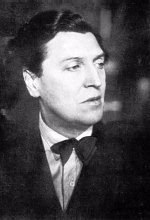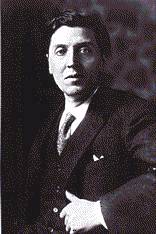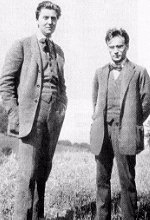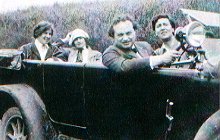 ... ...
Alban Berg
1900 - First compositions
Born on February 9th 1885 in Vienna as son of a bookseller, Alban
Berg ranks among the most important students of Arnold Schönberg besides
Anton von Webern. Already with fifteen years he started to compose first
lieder after Romantic and late Romantic models. Till 1908 he composed
about 140 lieder and instrumental compositions. Except „7 early lieder",
they are still unpublished.
Berg's youth was determined by his asthmatic disease, occurring for
the first time in 1900, and the early death of his father. An unrequited
love affair and an unsuccessful final examination (1903) ended in a suicide
attempt.
After having passed the final examination at the second attempt, he
worked from 1904 to 1906 as civil servant (accounting trainee)
for the Provincial government of Lower Austria, before an inheritance made
it possible for him to retire from this job.
1904 - Schönberg's student

Alban Berg and Anton von Webern
From 1904 to 1910, Alban Berg was Arnold Schönberg's
student and was close to the composer. He wrote for instance the piano
score of Schönberg's oratorio „Die Gurrelieder" and handled, during
Schönberg's absence in 1913, the preparations for the first
performance of the work, Franz Schreker conducting. Berg drew up also an
analytical guidebook of the „Gurrelieder"
.
1913 - Altenberg lieder - a scandal

Alban and Helene Berg
Due to the work for Schönberg, Berg had not much time to compose.
In 1907/08, he composed the piano sonata op 1, in 1909/10
the „Vier Lieder" op 2, in the fourth lied Berg left already the limits
of the tonality, and the string quartet op 3, a very personal work, in
which the composer gave musical utterance to his love relation to Helene
Nahowski (marriage on May 3rd 1911), as well as the „Altenberg-Lieder"
op 4, which caused an unprecedented scandal, as a result of their unconventional
use of the instruments and instrumental effects never heard before on the
occasion of the first performance on March 31st 1913 Schönberg
conducting, and ended in outcries and even fights in the audience. The
concert had to be stopped. (The lieder were completely performed, Jascha
Horenstein conducting, just in 1952 in Rome.)
Already before the concert, Berg had finished „Four pieces for
clarinet and piano" op 5, in which he experimented - in simultaneity with
the miniature-like works by Schönberg and Webern - with the scarcity
of the musical expression and the resulting aphoristic lyricism.
1914 - Three orchestral pieces
Both the scandal at the performance of the „Altenberg-Lieder" and Schönberg's
severe criticism led to a creative crisis. Despite depression, he worked
before, during and after the outbreak of World War I on „Drei Orchesterstücke"
op 3. These works have their origin in a previous idea to compose a symphony
and combine this idea with Schönberg's former suggestion to compose
a suite of character pieces. In 1915, Alban Berg was drafted for
military service. His compositional work was suspended for more than two
years. From 1916 to 1918, he was on duty at the Department
of War.
1917 - Wozzeck
In 1914, Alban Berg attended a performance of Georg Büchner's
drama fragment „Woyzeck" and made first sketches and drafts for his opera
„Wozzeck", which composition should occupy him the next seven years.
The opera „Wozzeck", which completion Berg resumed in 1917,
applied - after the overcoming of Richard Wagner's and Richard Strauss'
opera dramaturgy - new standards to the expressionistic music drama and
created the type of the „literary opera", a special genre of the music
drama going back to literary patterns. A formal scheme is the basis of
each of three acts including five scenes each. The first act is composed
of five character pieces, the second act represents a symphony with five
movements and the third act consists of five inventions. The strict formal
structure of each scene corresponds also to the closed cyclic structure
of the acts.
(Bild) Helene Berg, Alma Mahler-Werfel, Franz Werfel, Alban Berg
1923 - Dodecaphonic compositions
Like his friend and former „schoolmate" Anton von Webern, Berg took
up immediately Schönberg's „twelve-tone technique" when it became
known.
In the twelve-tone adaptation of his early lied „Schließe
mir die Augen beide" (text: Theodor Storm) he made use of the dodecaphony
still in a very simple way, but in his later compositions such as for instance
the „chamber concerto for violin and piano with thirteen wind instruments"
(1923-1925) he use it in a much more skillful and meticulous way.
In 1925, Berg met Hanna Fuchs-Robettin and had a love affair
with her until he died. He eternalized this secret affair in the „Lyric
suite" for string quartet (1925/26).
In the use of the twelve-tone technique, Alban Berg welds - unlike
Schöberg and Webern - the expressionism with late Romantic-like, emotional
demands into an inseparable whole. This comes out in the concerto aria
„The wine" (text by Charles Baudelaire, translation by Stefan George, 1929)
composed for the singer Ruzena Herlinger, but particularly in the „Violinkonzert
'Dem Andenken eines Engels'" (1935) dedicated to the early deceased Manon
Gropius, the daughter of Alma Mahler-Gropius-Werfel.

Helene Berg, Alma Mahler-Werfel,
Franz Werfel, Alban Berg
1928 - Lulu
In 1928, Berg started to compose his second (unfinished) opera „Lulu".
In 1905, Berg had attended a performance of Frank Wedekind's tragedy
„Pandora's box", which served him (together with „Erdgeist") as dramatic
model for his opera.
„Lulu" is based on a single twelve-tone series unlike the free-tonal
„Wozzeck". Berg depicts in glaring pictures and with complex music the
rise and fall of a „femme fatale" to whose fascination men succumb only
to be finally broken by her, before Lulu herself falls a prey to a sex
murder.
The work on this work was strenuous and determined by constant
self-doubts and Berg's deteriorated health, which delayed the completion.

Alban Berg died on December 23rd 1935 in Vienna as the result
of an insect bite. He left only two acts and numerous sketches for the
third act. Schönberg as well as other composers, who were close to
Berg, refused to finish the work on the basis of the existent sketches.
The Austrian composer Friedrich Cerha finished the opera only in 1979.
|